Jul 16 2020
The technique of nuclear magnetic resonance (NMR) is used in an extensive range of applications. In the field of chemistry, NMR spectroscopy is mainly used for analysis, and in the medical field, magnetic resonance imaging (MRI) is used to observe structures and metabolism within the body.
 Chemical reaction monitoring via zero-field nuclear magnetic resonance (NMR): A sequential hydrogenation reaction (ABC) is initiated inside a metal reactor inserted into a magnetically shielded enclosure. The NMR spectrum of the heterogeneous (gas/liquid) reaction is recorded with an atomic magnetometer positioned next to the reactor. Analysis of the spectra acquired during the course of the reaction reveals the changing concentrations of compounds B and C. Image Credit: John W. Blanchard.
Chemical reaction monitoring via zero-field nuclear magnetic resonance (NMR): A sequential hydrogenation reaction (ABC) is initiated inside a metal reactor inserted into a magnetically shielded enclosure. The NMR spectrum of the heterogeneous (gas/liquid) reaction is recorded with an atomic magnetometer positioned next to the reactor. Analysis of the spectra acquired during the course of the reaction reveals the changing concentrations of compounds B and C. Image Credit: John W. Blanchard.
Researchers at Johannes Gutenberg University Mainz (JGU) and the Helmholtz Institute Mainz (HIM), together with visiting scientists from Novosibirsk in Russia, have designed a new technique for observing chemical reactions. The researchers make use of NMR spectroscopy for this technique, but with a strange twist: There is no magnetic field present.
This technique has two advantages. For a start, we are able to analyze samples in metal containers and, at the same time, we can examine more complex substances made up of different types of components. We think our concept could be extremely useful when it comes to practical applications.
Dmitry Budker, Professor and Head, Mainz-based group, Johannes Gutenberg Universitat Mainz
NMR spectroscopy, as a chemical method, is employed to examine the composition of substances and to establish their structures. High-field NMR is used often and enables the non-destructive investigation of samples.
But this technique cannot be applied to visualize chemical reactions in metal containers since the metal serves as a shield, avoiding penetration of the comparatively high frequencies. Therefore, NMR sample containers are essentially made of ceramic, plastic, quartz, or glass.
In addition, high-field NMR spectra of heterogeneous samples consisting of more than one component are likely to be weak. Although more sophisticated concepts are available, they are often hampered by the inability to perform in-situ tracking of reactions.
Use of Zero- to Ultralow-Field Magnetic Resonance Proposed as a Solution
The research team under the guidance of Professor Dmitry Budker has suggested the use of zero- to ultralow-field nuclear magnetic resonance (ZULF NMR) to avoid these issues. The absence of a strong external magnetic field in this technique prevents a metal container from experiencing a screening effect.
For comparison, the researchers made use of a titanium test tube and a traditional glass NMR test tube in their experiments. For each test tube, the researchers bubbled para-enriched hydrogen gas into a liquid to begin a reaction between its hydrogen and the molecules.
The outcomes indicated that the reaction in the titanium tube could be easily tracked through ZULF NMR. The researchers were able to observe the kinetics of the reaction in progress at a high spectroscopic resolution while constantly bubbling para-hydrogen gas.
“We anticipate that ZULF NMR will find application in the field of catalysis for operando and in situ reaction monitoring as well as in the study of chemical reaction mechanisms under realistic conditions,” wrote the scientists in their article published in the leading scientific journal Angewandte Chemie International Edition.
Three scientists from the International Tomography Center in Novosibirsk were also engaged in the project, namely, Professor Igor V. Koptyug, who is a visiting scholar at HIM in Mainz, Dudari B. Burueva, a doctoral candidate of Koptyug who was also a visiting scholar and a joint first author of the recently published study, and Dr Kirill V. Kovtunov.
Sadly, our colleague Kirill Kovtunov passed away during the preparation of the manuscript for this publication. His contributions were very important to us.
Dmitry Budker, Professor, Johannes Gutenberg Universitat Mainz
In addition, a group of young researchers from HIM and JGU worked together in the research project, namely, joint first author Dr James Eills and Dr John W. Blanchard, together with doctoral candidates Antoine Garcon and Román Picazo Frutos.
Journal Reference:
Burueva, D. B., et al. (2020) Chemical reaction monitoring using zero-field nuclear magnetic resonance enables study of heterogeneous samples in metal containers. Angewandte Chemie International Edition. doi.org/10.1002/anie.202006266.
Source: https://www.uni-mainz.de/eng/